What is Real-Time Bidding (RTB)?
Real-time bidding (RTB) refers to the practice of purchasing and selling ads in real-time on a per-impression basis. It’s a subcategory of programmatic advertising.
RTB improved transparency regarding where publishers place ads and how advertisers bid for them. This technology facilitates the real-time monitoring of these metrics–a feature that’s unavailable in traditional advertising methods.
In this article you’ll learn what RTB is, how it works and how to maintain it for a more efficient ad campaign optimization!
What is Real-Time Bidding?
Real-time bidding (RTB) is a technology-driven process used in digital advertising. It involves an automated auction system for purchasing individual ad placements (ad impressions) on different online platforms like websites, apps, and games.
Real-time bidding operates through algorithms that work in real-time to optimize the buying and selling of ad impressions. The goal is twofold:
- To ensure that publishers receive the highest possible payment for each impression.
- To help advertisers display their ads to the most relevant and suitable audience.
The definition of real-time bidding?
According to IAB (International Advertising Bureau), real-time bidding is a way of selling media that enables an ad impression to be put up for bidding in real-time.
How does RTB differ from traditional advertising?
Traditional advertising requires time to develop requests for proposals, conduct negotiations, and create insertion orders–it’s done manually on a one-to-one basis, therefore it takes more time and effort.
Real-time bidding helps to make the buying and selling of programmatic ads more efficient.
While RTB offers precise targeting, efficiency, and data-driven decision-making, traditional advertising provides broad reach, control over ad placements, and familiarity.
The Role of RTB in Programmatic Advertising
RTB is a fundamental part of programmatic advertising–an advanced approach that uses automation to streamline buying and placing ads across different digital channels.
While real-time bidding is a type of programmatic advertising, it’s important to recognize that programmatic advertising includes a broader spectrum of automated ad space trading.
It’s an umbrella term for other automated digital ad space trading types (programmatic deals), such as:
- Programmatic direct. This type of programmatic advertising doesn’t involve participating in any auctions. Instead, advertisers and publishers engage in a direct, one-to-one transaction. Advertisers purchase ad inventory directly from publishers at predetermined prices. This method is similar to traditional ad buying, but it’s facilitated through automated platforms.
- Programmatic guaranteed. In this approach, advertisers participate in private and invite-only auctions. Publishers offer specific ad inventory to certain advertisers under agreed-upon terms. This guarantees that the advertisers’ ads will be shown in the designated spaces, providing a level of assurance and control.
- RTB Programmatic. RTB programmatic involves buying impressions in open auctions through the real-time bidding process. Advertisers bid on available ad impressions in real time, and the highest bidder’s ad gets displayed. This method is characterized by its real-time nature and the competition between advertisers for the best placements.
How is RTB a form of programmatic buying?
In essence, RTB is a specific type of programmatic ad buying that revolves around automated bidding in auctions. While all RTB is programmatic, not all programmatic advertising relies on RTB.
Programmatic ad buying includes various automated processes for ad placements, but RTB stands out as a method where advertisers bid in real time to secure impressions.
However, it’s important to note that not all programmatic advertising necessarily uses RTB.
Some advertisers may opt for direct agreements with publishers that do not involve real-time bidding but rather pre-negotiated terms.
How Does Real-time Bidding (RTB) Work?
The real-time bidding process starts when a user enters a webpage or an app with available ad space.
Advertisers interested in showing their ads submit bids in real-time based on various factors–the size and placement of the ad, information about the website or app, and details about the intended audience.
The algorithm quickly evaluates these bids and selects the highest one. The winning bidder’s ad is then displayed to the user in the available ad space on the webpage or app.
This process ensures that each ad impression is assigned a value based on the potential impact it could have and the ad’s relevance to the viewer.
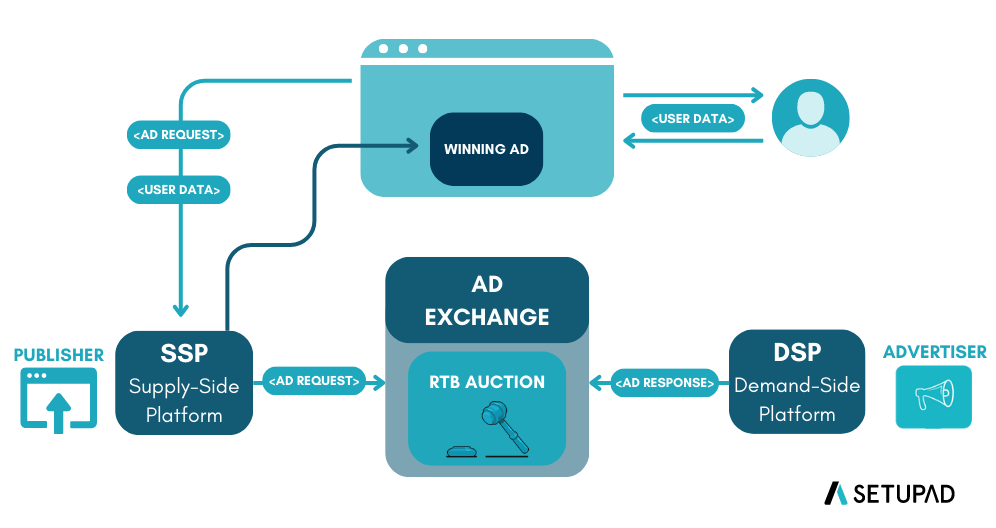
Key players in the RTB process
RTB is a complex process within the world of digital advertising that involves several key players and technologies:
| RTB Key Players | Purpose |
| Advertiser | The company or brand that wants to display its ads online to reach its target audience. |
| Publisher | A website or online platform that wants to monetize its content by selling ad spaces within its digital real estate. This available ad space is often referred to as ad inventory. |
| Ad Impressions | Instances when an ad is displayed to a user. In RTB, advertisers typically pay for ad impressions based on a cost-per-thousand impressions (CPM) model. |
| Demand-Side Platform (DSP) | A technology that advertisers use to manage and launch their ad campaigns. It allows advertisers to set campaign parameters, such as target demographics, locations, and budgets. |
| Supply-Side Platform (SSP) | A technology publishers use to manage and make their ad inventory available for sale. SSPs facilitate the process of connecting publishers with potential advertisers. |
| Ad Exchange | Digital marketplace that bring together advertisers and publishers. It functions as an intermediary, facilitating the real-time auction process of buying and selling ad impressions. |
RTB auction process explained
Now, since you understand who are the key players in the RTB process, let’s put all these elements together to understand how real-time bidding works:
- Advertiser setup. Advertisers use DSPs to create ad campaigns. They define the target audience, budget, ad creatives, and other campaign details.
- Publisher listing. Publishers utilize SSPs to list their available ad inventory and the pricing for each impression. This information is shared with potential advertisers through an ad exchange.
- Ad exchange auction. When a user visits a publisher’s website or app, the available ad spaces are auctioned in real time on the ad exchange.
- Targeting and bidding. Through their DSPs, advertisers evaluate the ad inventory and decide which impressions to bid on. They can set specific targeting criteria to ensure their ads are shown to the right audience (e.g., users from a specific region or who recently visited their website).
- Bidding decision. Advertisers’ DSPs make real-time decisions on whether to bid for an ad impression and how much to bid based on their campaign goals and targeting criteria.
- Auction outcome. Advertiser bids are submitted to the ad exchange. The highest bid wins the auction for that particular impression.
- Ad display. If the advertiser’s bid wins, the ad is displayed in the designated ad space on the publisher’s website or app.
- Billing. Advertisers are billed based on the number of impressions their ad receives, following the CPM model.
RTB protocol backbone and taxonomy
The RTB protocol relies on taxonomy, which serves as a standardized framework for DSPs and SSPs to consistently name and understand different data components.
This common language helps to ensure that various platforms interpret data similarly, facilitating efficient communication. Additionally, the RTB protocol includes rules governing data sharing and usage to align with data protection laws and privacy regulations.
There are multiple RTB protocols in use. For example, Google employs its proprietary protocol, Authorized Buyers Real-time Bidding Proto.
However, the most widely recognized and respected RTB protocol is OpenRTB (ORTB), developed and maintained by the IAB Tech Lab. ORTB is considered the gold standard due to its industry-wide acceptance and adherence to best practices.
What Are RTB Platforms?
There are no standalone RTB platforms in the sense of specific platforms dedicated solely to real-time bidding. Instead, it consists of a dynamic ecosystem with various interconnected platforms collaborating to streamline and enhance ad operations.
RTB platforms include SSPs for publishers, DSPs for advertisers, marketplaces such as ad exchanges, data management platforms for data storage, and ad networks that act as intermediaries in the ad serving process.
It’s vital to understand that RTB is not a distinct advertising channel but a technique that occurs within existing advertising channels.
For advertisers
As an advertiser, you aim to find a DSP that empowers you to efficiently oversee multiple ad campaigns while tuning your targeting criteria to users’ frequently visited websites and preferred brands.
There are several DSPs available, such as:
- Google DV360–offers extensive reach and access to Google’s vast inventory, including Google Display Network, YouTube, and other Google’s properties.

- Beeswax–gives access to all the traditional DSP features (e.g., fully featured user interface, analytics dashboard, and robust targeting options), and offers a customizable DSP to build your own programmatic buying solution and decisioning algorithms.
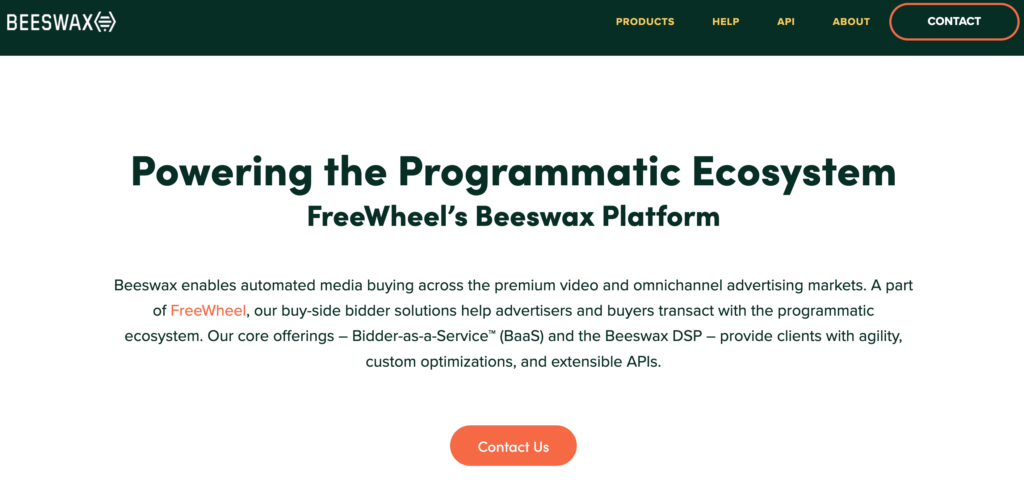
- theTradeDesk–enables you to place ads on multiple devices (e.g., web, apps, TV, music streaming devices, etc.)
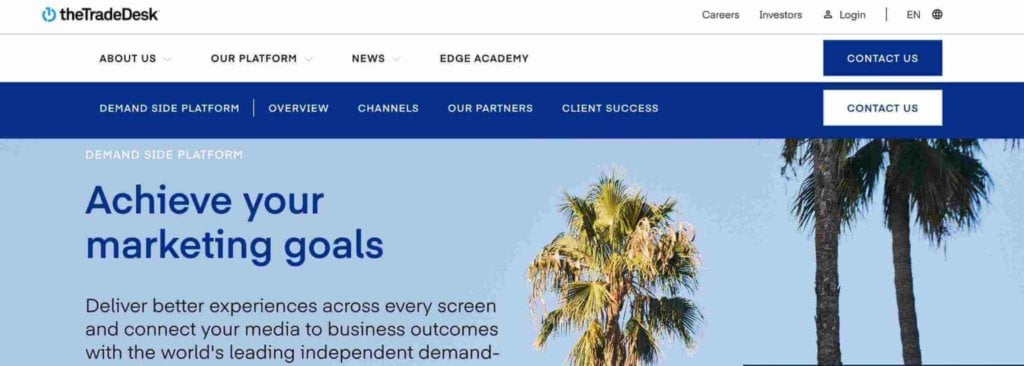
For publishers
If you possess ad inventory and wish to leverage the benefits of the real-time bidding process, it’s crucial to register with a SSP.
This enables you to tap into the efficiency and automation of real-time auctions without directly interacting with advertisers or manually managing account negotiations and operations.
There are several SSPs available, such as:
- Magnite–offers both DSP and SSP services. As an SSP, it offers rich reporting functionality, Prebid support, live streaming monetization, PMP deals, ad pod control, and many other features.
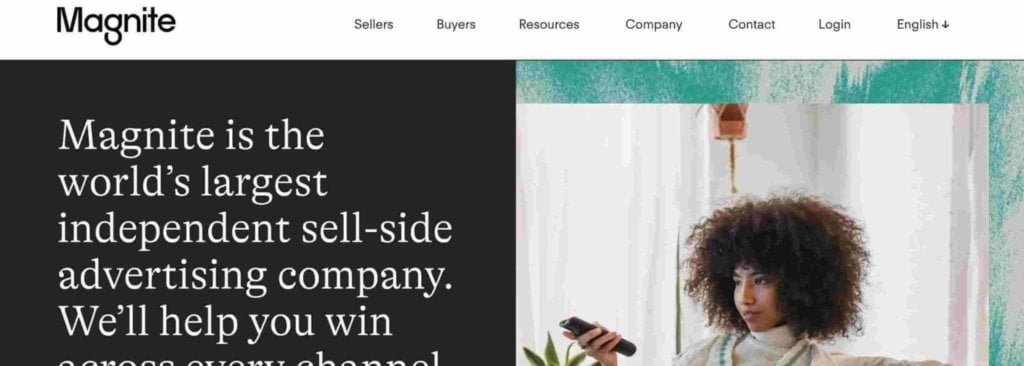
- OpenX–one of the oldest SSPs on the scene. OpenX has secured partnerships with major companies to help drive premium demand for publishers. It also offers custom SPO arrangements and identity resolution.
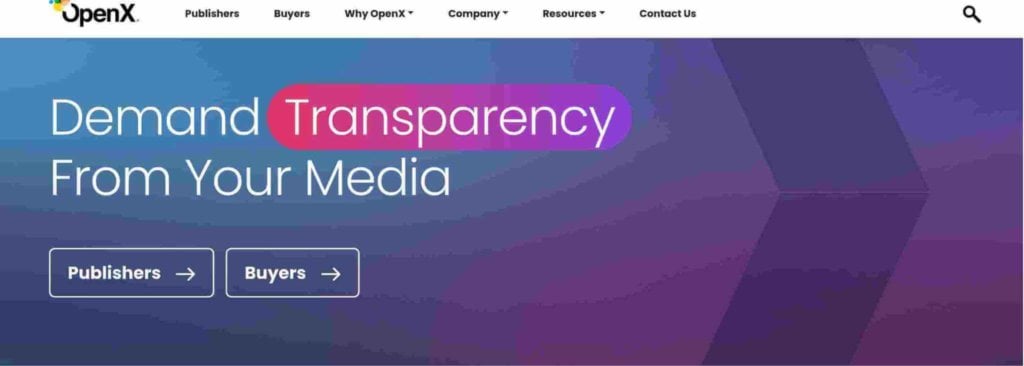
- Xandr–offers both a DSP, SSP, and ad exchange services. Being a wholesome ad tech platform, it enables everything from real-time bidding and programmatic buying, and data management to dynamic creative optimization tools and audience targeting.
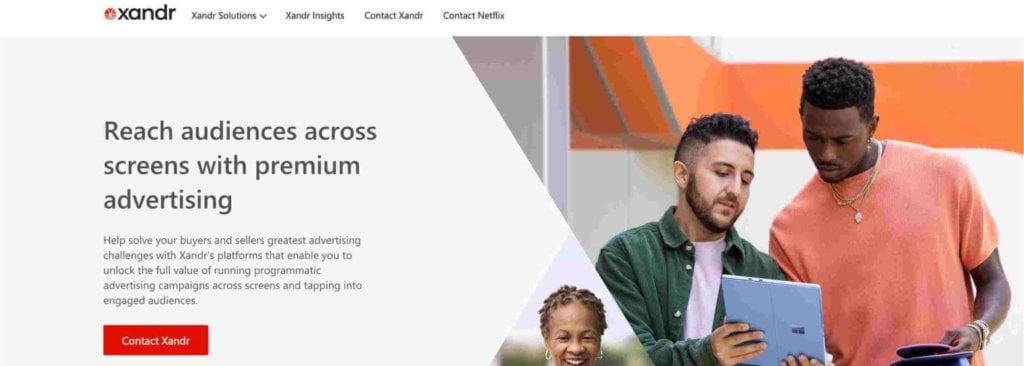
Why is RTB Important in Today’s Advertising Landscape?
RTB is a process in programmatic advertising that offers significant advantages.
- Firstly, there’s no need for ad buyers to work directly with publishers or ad networks to agree upon ad prices and deliver ads with RTB advertising.
This streamlines the ad buying process, reducing the time and effort traditionally spent on negotiation. Besides, there’s no need to waste money and time searching for the proper inventory to display their ads for advertisers.
RTB also addresses the challenge of efficiently finding appropriate ad inventory for advertisers.
Instead of spending resources searching for the right placements, RTB allows advertisers to participate in real-time auctions where they can bid for impressions on websites or apps that match their target audience.
- Secondly, RTB is measurable and action-encouraging. Both publishers and advertisers can check the campaign’s results instantly.
This immediate feedback loop allows for real-time optimization, ensuring that campaigns can be adjusted on the fly for better results. This dynamic measurement and optimization process makes RTB a powerful tool for achieving campaign goals.
RTB provides advertisers with the agility to make rapid adjustments to their campaigns.
Similarly, publishers have the flexibility to modify key parameters such as the floor price and ad unit placements whenever needed.
The benefits of using RTB in marketing strategy
For publishers
Here are the 5 main advantages of real-time bidding for publishers:
- Content and format control. Publishers can have control over what content and ad formats appear on their websites or mobile apps. They can actively manage the ads to ensure they align with their brand’s values and ban ads containing sensitive or inappropriate content.
- Increased revenue from unsold inventory. Publishers can sell their unsold ad inventory, which might otherwise go unused, at potentially higher prices. This helps maximize revenue by tapping into demand from advertisers participating in the real-time auctions.
- Dynamic pricing. Publishers have the flexibility to adjust their prices in response to real-time demand and the bids placed by advertisers. This allows them to optimize revenue by finding the balance between competitive pricing and attracting advertisers.
- Private marketplaces. RTB facilitates the creation of private marketplaces, where publishers can offer premium inventory exclusively to select advertisers. This provides an opportunity to sell high-quality ad spaces to strategic partners.
- Relevance to Audience. RTB enables publishers to ensure that the ads displayed on their platforms are relevant and engaging for their audience. This relevance improves the user experience and engagement, benefiting both the users and the publisher’s ad revenue.
For advertisers
Here are the 4 main advantages of real-time bidding for advertisers:
- Campaign control. RTB offers advertisers a higher level of control over their ad campaigns. They can actively manage and tailor various aspects of their campaigns, ensuring that their brand’s message and image align with their desired placements and target audience.
- Audience targeting. RTB enables advertisers to refine their target audience based on factors such as demographics, language, and location. This granularity enhances the efficiency of campaigns, as ads are shown to users who are more likely to be interested in the offerings.
- Real-time strategy adjustments. Advertisers can make informed decisions about their marketing strategies as their RTB campaigns progress. They have the flexibility to modify bidding strategies and adjust campaign elements in response to real-time results, ensuring optimal performance.
- Budget management. Advertisers can maintain control over their budget by leveraging maximum bid options. This ensures that bids remain within the desired range, preventing overspending. Additionally, the ability to avoid bulk buying allows advertisers to allocate their budget more strategically and efficiently.
Potential drawbacks of RTB to be aware of
Here are 4 potential drawbacks of real-time bidding:
1. Complex implementation and management
RTB involves a technologically complicated process that demands significant resources to set up and maintain. This complexity can be both time-consuming and costly.
To participate effectively in RTB auctions it requires advanced technology, data analysis capabilities, and a deep understanding of the digital advertising landscape. This can challenge smaller businesses or those without the necessary expertise.
2. Risk of fraud
RTB can expose advertisers to fraudulent activities like fake clicks, impressions, or traffic. Advertisers may end up paying for interactions that are generated by bots or other fraudulent means rather than real human users.
3. Privacy concerns
RTB involves the exchange of user data to enable targeted advertising. However, this data exchange raises privacy concerns, as personal information is shared across various platforms. This can lead to regulatory challenges and issues related to user privacy.
4. No guaranteed deals
Unlike programmatic guaranteed deals, where certain inventory is pre-sold at a fixed price, RTB operates based on the principles of demand and supply, filling available ad inventory through dynamic auctions. This fundamental difference has implications for revenue generation and ad delivery predictability.
In RTB, the revenue generated for specific ad units can vary significantly due to fluctuations in demand from advertisers participating in the auction. Some ad units might yield high revenue due to increased demand, while others may yield lower revenue due to fewer buyers participating at that moment.
Furthermore, RTB lacks the assurance of guaranteed ad fill as it hinges on the interest and bidding activity of potential buyers. This inherent unpredictability affects publishers’ revenue, as there’s no guarantee that all available ad inventory will be filled through RTB at all times.
RTB vs Header Bidding
Header bidding is a part of real-time bidding.
Just like real-time bidding brought improvements to programmatic buying, header bidding was an improvement to RTB.
Here’s an ad tech history example that helps to explain how this technology has advanced:
- Ad exchanges were introduced in 2005 as a technological advancement to automate buying and selling ad space on digital platforms. These platforms provided a more efficient way for advertisers and publishers to connect and exchange ad inventory.
- Real-time bidding emerged in 2009 as a significant enhancement to ad exchanges. RTB introduced a dynamic auction system where advertisers bid in real time to purchase ad impressions. This real-time approach improved the efficiency and effectiveness of auctions within ad exchanges.
- Header bidding technology was developed around the years 2014-2017. It was designed to enhance the RTB process further. Header bidding provides a mechanism that allows publishers to offer their ad inventory to multiple ad exchanges and demand sources simultaneously before the actual ad call to their primary ad server.
In other words, header bidding is a subset of real-time bidding and real-time bidding is a subset of programmatic advertising. And it’s essential to understand that header bidding isn’t the only subset of RTB, neither is RTB the only subset of programmatic advertising.
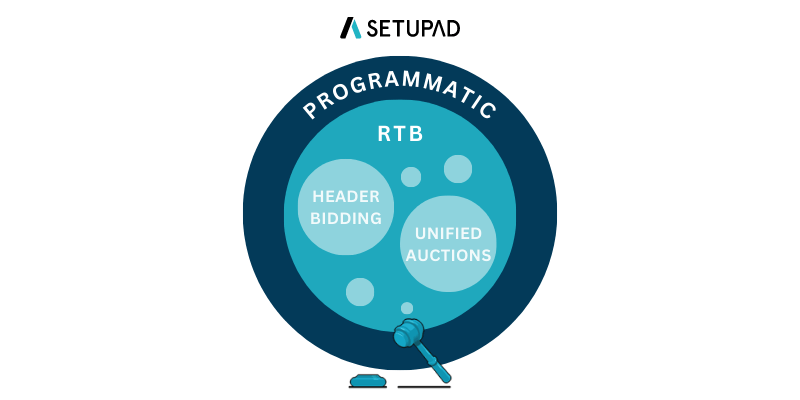
Setupad’s header bidding solution comprises the most advanced and complete ad stack. Our hybrid header bidding wrapper includes server-to-server integrations to Prebid server, Amazon’s TAM, and Google’s Open Bidding, which account for at least 35% of the winning bids.
It’s a light tag-based solution that doesn’t require pasting anything into the source code.
Additionally, our clients benefit from an advanced technology suite, programmatic expertise, superior customer service, and an individual approach.
Header bidding took the RTB process a step further by enabling an ad impression to be put up for auction across multiple demand sources simultaneously, instead of running the auction through each demand source one at a time, which is known as waterfalling.
How header bidding improved RTB?
Here are the 3 ways how header bidding improved RTB:
- Simultaneous auction–header bidding improved on the traditional sequential process of RTB by enabling multiple demand sources to participate in the auction at the same time.
This means that all potential advertisers can submit their bids at the same time, leading to increased competition and potentially higher prices for ad impressions.
- No waterfalling–the term “waterfall” refers to the sequential order in which demand sources are considered for an ad impression. In traditional RTB, the ad impression is offered to one demand source at a time, and if that source doesn’t win the auction, the impression is passed down to the next one in line.
This sequential process can sometimes result in missed opportunities and reduced efficiency.
- Efficiency and revenue–header bidding’s simultaneous auction approach eliminated the need for waterfalling and reduced latency in the ad serving process.
This improved the overall efficiency of ad auctions and can lead to increased revenue for publishers, as demand sources can bid competitively without delay.
What is The Programmatic Open Exchange?
An open ad exchange, also known as an open marketplace, functions as a space for the buying and selling of digital advertising inventory, offering a potent tool for both advertisers and publishers.
The open exchange marketplace represents an opportunity to access a previously untapped audience for advertisers. The transparency inherent in the open exchange empowers advertisers to gain insights into their audience’s behavior, fostering the creation of new strategies for raising brand awareness.
On the other hand, publishers can obtain valuable insights into the level of interest in their inventory and the corresponding willingness to pay from potential advertisers, enabling more informed decision-making.
The role of RTB within the programmatic open exchange
Open exchange uses real-time bidding to operate. In this setting, live auctions are used to dynamically determine the costs for available ad spaces. This inclusive auction model permits any advertiser or publisher to participate.
In this dynamic, participants compete with one another for the chance to display ads, with the highest bidder eventually winning the ad impressions.
Maximizing the Use of RTB for Web Publishers
Here are our 4 main tips for maintaining and maximizing the use of RTB:
1. Diversify your programmatic approach
In programmatic advertising, there are several types of approaches, and it’s vital for publishers to adopt a comprehensive strategy that includes multiple programmatic approaches to maximize revenue potential.
By combining different types of programmatic advertising, publishers can establish a well-rounded and effective strategy to achieve their revenue and advertising goals.
For example, preferred deals allow direct negotiation for premium placements, ensuring stable income. Meanwhile, the open auction fosters competition and agility for the remaining inventory.
Although the idea of integrating various programmatic ad types might seem complex, this approach actually contributes to a more controlled and stable revenue flow. Employing a mix of strategies ensures that publishers meet the diverse needs of their advertisers and users, and have greater control over their revenue streams.
2. Create multi-platform RTB campaigns
RTB campaigns must be flexible due to the rise in mobile device usage and the wide range of screen sizes and platforms. In order to guarantee that ads are delivered effectively across a variety of devices and platforms, responsive design is essential.
Consistency in the user experience across different devices and platforms is fundamental for building brand trust and fostering customer loyalty. Employing responsive, multi-platform campaigns guarantees that your ads are seamlessly and consistently delivered regardless of the device or platform.
3. Use multiple ad formats
You should experiment and test different ad formats to identify the most effective one for your website and audience. Evaluating metrics like clicks and conversions will provide insights into what resonates best with your target audience.
Moreover, the user experience is essential when considering ad placements on your site.
When determining the most suitable ad format for your site, carefully weigh each option’s advantages and disadvantages. Some examples of ad formats include:
- Banner ads. One of the most popular ad formats available. They usually have static elements (image or text), they’re considered less intrusive than other ad formats, and users usually click on them intentionally.
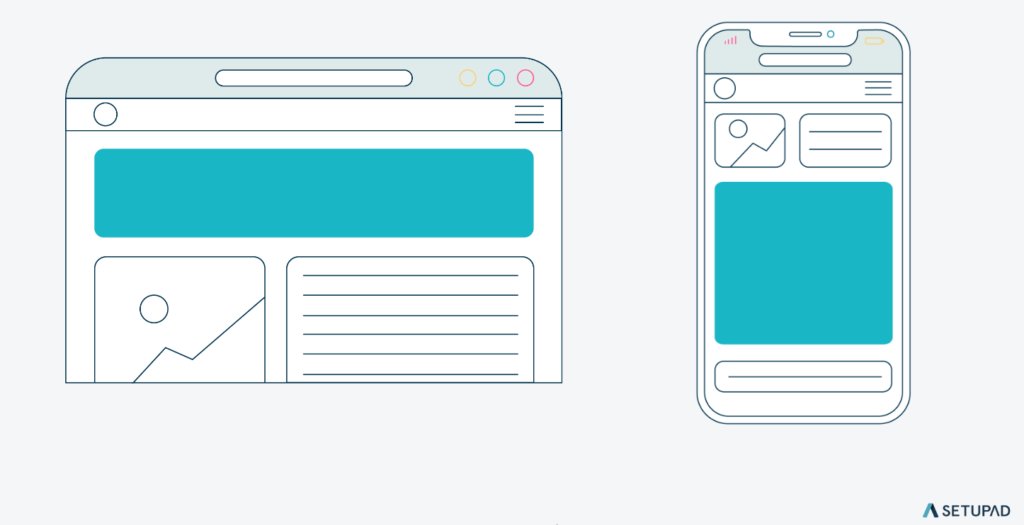
- Native ads. Native ads blend seamlessly with the surrounding content, enhancing user experience by appearing less intrusive. Native ads usually appear in social media feeds or as promoted search results.
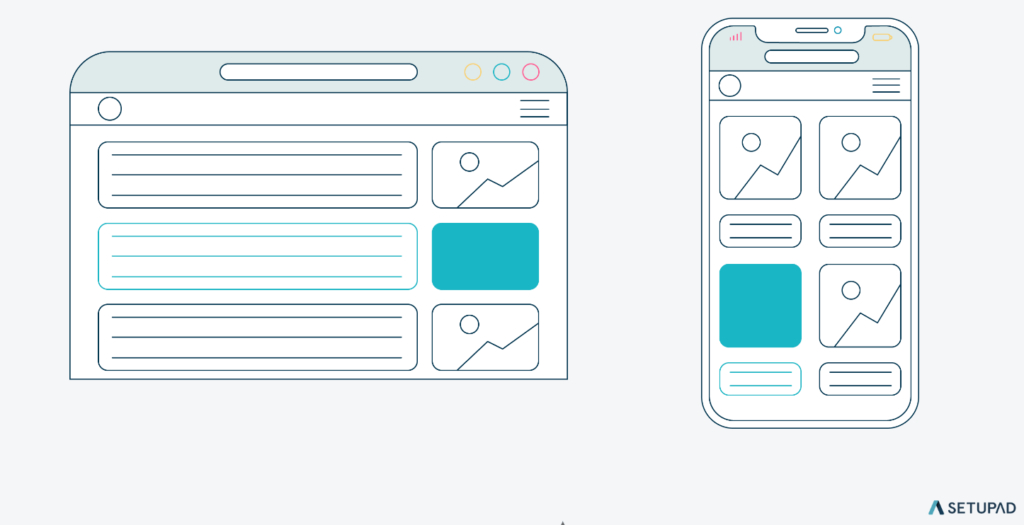
- Interstitial ads. Interactive, full-screen ads that are displayed when a user switches to another page. They can increase website’s ad diversity and the overall ad engagement, and minimize banner blindness. This ad format has higher CTRs compared to standard ad formats.
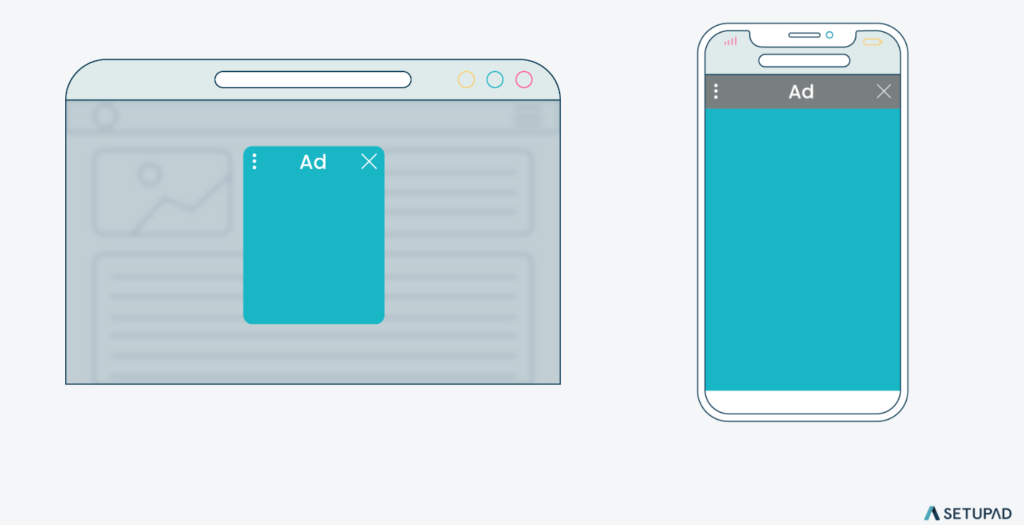
Note that overloading your site with excessive ads could distract or annoy users, potentially driving them away. A key consideration is balancing the number and placement of ads to ensure they enhance rather than disrupt user engagement.
4. Optimize your bid floors and monitor your blocklist
Bid floors represent the minimum bid that a publisher is willing to accept for ad placement. Monitoring bid floors ensures that you’re not overspending on ad placements. By being cautious in this area, you may find a balance between cost-effectiveness and competitive bidding, ensuring that you get the best results without facing extra costs.
A blocklist consists of URLs, keywords, or other criteria that you don’t want your ads to appear next to. It’s essential to often check your blocklists to protect your brand’s reputation. This stops your ads from appearing on inappropriate or low-quality websites, which could damage the reputation of your company.
You can quickly identify any noteworthy adjustments or patterns by constantly reviewing bid floors and blocklists to keep your campaign in line with your RTB goals.
Conclusion
Real-time bidding offers streamlined ad buying, efficient ad inventory selection, and immediate campaign measurement. It plays a vital role in the world of programmatic by enhancing efficiency, effectiveness, and agility for both advertisers and publishers.
RTB empowers advertisers to reach their target audiences, adapt campaigns in real time, and make the most of their ad investments. Similarly, publishers benefit from instant performance feedback and the ability to adjust ad parameters swiftly.
A monetization partner can help you optimize your ad campaign strategy by providing the expertise, technology, and tools needed to navigate the complex landscape of programmatic advertising.
If you would like to test our solution for yourself, sign up or contact us at [email protected].


